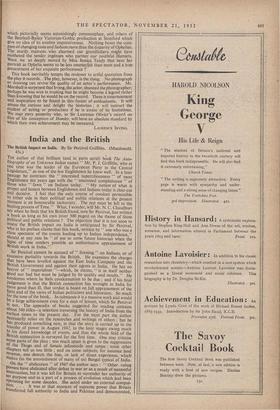Commentary on "Hamlet"
Hamlet Through the Ages. By Raymond Mander and Joe Mitchen- son. Edited by Herbert Marshall. (Rockcliff. 35s.) THIS book is fascinating, and important—as any commentary upon Hamlet must be. Mr. Herbert Marshall has surprised those theatrical magpies, Messrs. Mander and Mitchenson, in their, nest, and from their treasure has produced an incomparable pictorial record of representations of Hamlet since the play became pre- eminent in the classical repertoire of the English theatre.
In a challenging introduction Mr. Marshall deplores the dearth of theatrical records, argues the practical need for productions of con- sequence to be adequately documented and filed, and pays just tribute to the loving labour of his collaborators in their efforts to preserve the scanty illustrations of the history of the theatre. Then comes the play—scene by scene, each with a brief synopsis of its action followed by abundant and well-annotated pictures of its interpretation by actors, producers and designers of many countries and p.!riods. This admirable arrangement enables us, for instance, to compare the various contrivances of the Ghost, from his creaking elevation through a primitive trap-door to the apocalyptic flash of his revelation in the Czech National Theatre.
We soon realise that this is a record only of the form ; the spirit still eludes us. The most naive, stuffy and ludicrous tableau may be a frozen aspect of a great and moving performance, while a compo- sition which fulfils the principles of graphic art may be the back- ground of a stilted and pedestrian company of actors. We must remember, too, that a straightforward photograph of a play in action will not flatter scenic or lighting effects, while a composition artfully contrived during an interminable photographic call can endow an indifferent production with illusory qualities.
No play in any language has inspired so much invention and experiment, much of it misguided. Very few of these tableaux evoke a recognition of apt illustration ; those that do are the most simple —as for example the productions at the Polish and Czech National Theatres.
As we turn the pages we may wonder which of all these interpre- tations Shakespeare would have applauded. It appears that scale has something to do with it—that the equation of man's stature in proportion to his background may be relative to the grandeur of the poet's expression. A tea-room quartet cannot do justice to a symphony by Beethoven ; it is not only the inadequacy of the players but the tea-room itself that curbs our emotional response. Similarly, since the essence of the Prince is nobility, it is easier to conceive the performance of Mounet-Sully, although his make-up is fusty and bewigged, than that of a modern-dress Hamlet who looks like an adolescent ship's steward. It is possible that Shakespeare, impatient as he was with the inadequacies of the Globe, would reject William Poel's shoddy contraption, which, however worthy its aim, bears no more resemblance to an Elizabethan playhouse than a meeting of the Browning Society did to the society of Browning.
Perhaps Shakespeare would have preferred the John Barrymore- Robert Edmond Jones production at the Haymarket Theatre in 1925 ; those who saw it will testify that the playing of Barrymore and his company matched its pictorial excellence. There have, of course, been fine performances of Hamlet by contemporary English actors ; this record, however, suggests that maybe owing to economic stress they were too ready to accept an undistinguished mise-en-scene in which the dresses, in trying to enliven the dreary functionalism of the settings, seem to be the confections of the costumier rather than the accoutrements of life and character.
There is a good deal of comic relief to be found in these pages- Macready gesticulating before a portrait of Siamese twins resembling an unhappy union of Hamlet ',ere and Claudius : Kamawaki, the Japanese Hamlet, the very picture of dejection, inspired less, perhaps, .by the assumption of Hamlet's burden than by the difficulty of persuading his audience to doubt the efficacy of suicide ; the cock- eyed oriental romp of a Hamlet in the Uzbek State Theatre. There are evidences of cosmopolitan vulgarities in every decade. We must deplore some glimpses of a B.B.C. television production in 1947
which pictorially seems astonishingly commonplace, and others of the Benthall-Bailey Victorian-Gothic production at Stratford which give no idea of its sombre impressiveness. Nothing boxes the com- pass of changing taste and fashion more than the disparity of Ophelias. The sturdy matrons who charmed our grandfathers might have mothered the tender ingénues who partner our youthful Hamlets. Were we so deeply moved by Miss Jessica Tandy that here her portrait as Ophelia seems to be less counterfeit than most and a true Presentment of her exquisite performance ?
This book inevitably tempts the reviewer to artful quotation from the play it records. The play, however, is the thing. No photograph or drawing can revive the quality of an actor's performance. Mr. Marshall is surprised that Irving, the actor, shunned the photographer; Perhaps he was wise in trusting that he might become a legend rather than knowing that he would be on the record. There is entertainment and inspiration to be found in this fusion of enthusiasms. It will amuse the curious and delight the historian ; it will instruct the student of acting or production if he is aware of its limitations. We may envy posterity who, in Sir Laurence Olivier's record on film of his conception of Hamlet, will have an absolute standard by which their own achievement may be measured.
LAURENCE IRVING.











































































 Previous page
Previous page